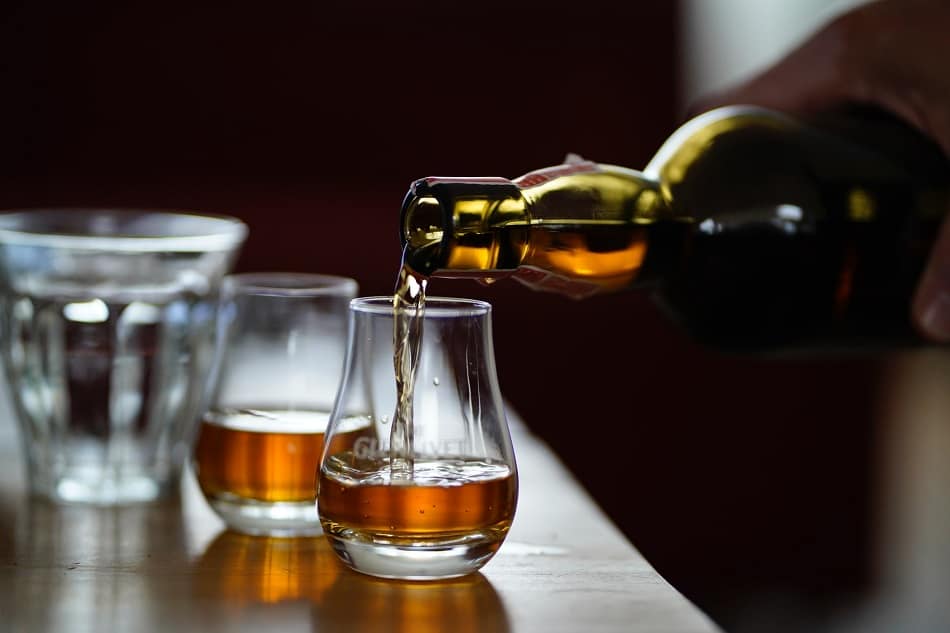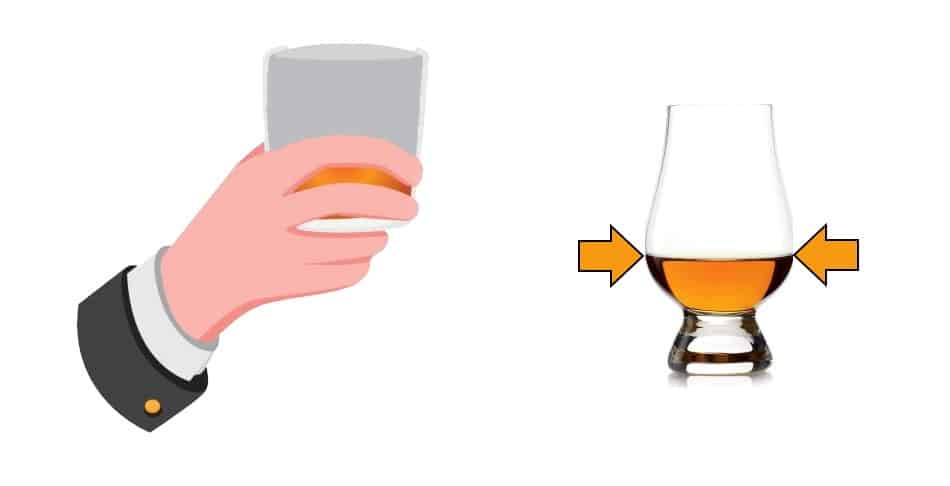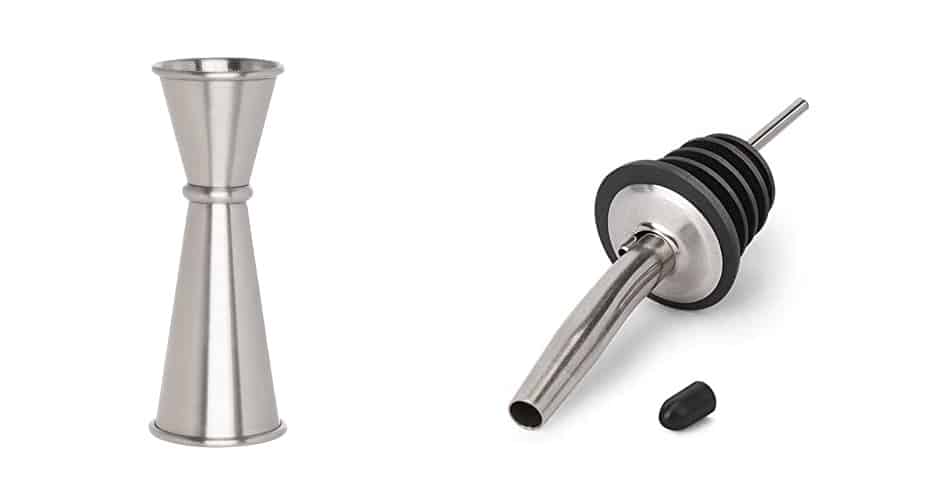When it comes to drinking whiskey, every aspect is carefully considered, even something as simple as how much to pour for one glass. While there are no formal rules for this there are some general guidelines.
The amount of whiskey you should pour for one glass depends on how it’s being drunk.
- For a shot of whiskey pour 1 – 1.5 fl oz
- For a whiskey cocktail pour 1.5 – 2.5 fl oz
- For whiskey neat or on the rocks pour 2 fl oz
- For a whiskey double pour 2.5 – 3 fl oz
As a rough guide pour the equivalent of one or two fingers height against the glass.
While these amounts may seem arbitrary there are in fact some sensible reasons for them. There are also other variables which may change the amount of whiskey you should pour and different ways to measure out the right amount of whiskey. Let’s take a closer look.

How Much Whiskey You Pour Depends on How You’re Drinking It
Since there are different ways to drink whiskey there are also different pour amounts.
Whiskey Shots
Whiskey shots are small amounts of whiskey drunk quickly and in one gulp or swallow. These are great for friends who all want to have a drink at the same time or for when you want to get drunk quickly and easily.
That’s why for whiskey shots, pour anywhere from 1 fl oz which although a bit on the skimpy side might be fine if you’re having more than one, and 1.5 fl oz which is substantial enough to make anything more, difficult to have in one go.
Whiskey Cocktails
Whiskey cocktails contain anywhere from 1.5 – 2.5 fl oz of whiskey, recipe dependent. This is a nice amount of whiskey to be part of a more substantial drink.
Here are six of the most popular whiskey cocktails, the amount of whiskey they have and the amount of other ingredients. As you can see the amount of whiskey varies as does its proportion in relation to all the other ingredients.
| Whiskey | Other Ingredients | |
|---|---|---|
| Manhattan | 2 fl oz Bourbon, Rye whiskey or Canadian whiskey | 1 fl oz sweet vermouth, 2 – 3 dashes of aromatic bitters and a cherry garnish |
| Old Fashioned | 2 fl oz Bourbon or Rye whiskey | 2 – 3 dashes of bitters, 1 sugar cube (or ½ teaspoon sugar), orange peel and a cherry garnish |
| Whiskey Sour | 2 fl oz of whiskey | ¾ fl oz lemon juice and ½ – ¾ fl oz simple syrup with cherry or lemon peel garnish |
| John Collins | 1½ fl oz whiskey | 1 fl oz lemon juice, ½ fl oz simple syrup, 2 fl oz club soda and cherry or orange slice garnish |
| Whiskey Highball | 2 fl oz whiskey | 4 – 6 fl oz ginger ale or club soda |
| Mint Julep | 2½ fl oz bourbon | 4 to 5 mint sprigs and 2 sugar cubes (or ½ fl oz simple syrup) |
Whiskey Neat or on the Rocks
When you drink whiskey neat or on the rocks the point is not to get drunk but to have a substantial drink whose flavors you can taste.
That’s why the amount of whiskey you pour for a whiskey neat or on the rocks is 2 fl oz.
It’s a more substantial amount than a shot of whiskey and allows for four or five sips to really assess the flavor. (Oh, and if you sip 2 fl oz of whiskey you’re less likely to get drunk than drinking 1.5 fl oz in one go).
More importantly, pouring only 2 fl oz leaves plenty of room in the glass for air to get to the whiskey so it can breathe and let the ethanol evaporate. That way the alcohol and its effects are reduced allowing the whiskeys aromas and flavors to be more easily detected.
The extra space also allows you to add ice to chill your drink and then as it melts, dilute it and bring out more flavors because every drop of water changes the taste of your whiskey.
This doesn’t mean that you’re only allowed 2 fl oz of whiskey. Some people have two or three or more glasses of whiskey in one drinking session, but 2 fl oz is how much you should pour at a time.
Of course, if you do pour yourself more or less than 2 fl oz that’s fine too, but you probably won’t want much more than that in one glass of whiskey.
The Rough Guide to How Much Whiskey You Should Pour

Whilst the above are some good guidelines, sometimes you won’t have any tools available to measure the precise amount of whiskey that you’re pouring. And sometimes you wouldn’t want to even if you do. (‘I think it’s 2 fl oz, honey’.)
That’s where the rough guide to how much whiskey you should pour comes in.
The height of one finger against a regular sized glass is about 1 fl oz and the height of two fingers against a regular sized glass is about 2 fl oz. Therefore, when pouring a whiskey neat you can use the two fingers rule of pouring the equivalent of two fingers height against the glass – unless you have very small hands.
Another rough guide to how much whiskey you should pour is to the level of the glass where its diameter is widest. This rough guide is only for nosing glasses as they have wide bowls and long narrow necks, because if you used this method on a tumbler with straight sides, its widest point is often at the top.
There are a number of disadvantages to pouring whiskey using a rough guide. The first is if you add water to whiskey to bring out its flavors. Since, as already mentioned, every drop of water changes the taste of the whiskey, there will be a specific number of drops of water that will bring out your preferred flavor for a given amount of whiskey. In such a case you would want to be as precise as possible in how much whiskey you pour so that the specific amount of water you add does its job.
The other disadvantages are that it makes it more difficult to track your alcohol consumption and how much of your expensive whiskey you’ve drunk.
Other Variables That Effect How Much Whiskey You Should Pour
There are two other variables which may change the amount of whiskey you should pour for one glass.
The first is whether you’re drinking whiskey to focus on the flavors or just to relax. Although you’ll also want to taste the flavors even when you’re relaxing, you probably won’t be using all your powers of concentration and taking extensive notes. Some people pour 2 – 2.5 fl oz when they’re relaxing because it’s a pain in the neck to repeatedly pour more, but about 1 fl oz when really engaged in their tasting.
The second variable that may change the amount of whiskey you should pour for one glass is who you’re pouring for. Pouring for yourself is one thing but pouring for guests is quite another. If your guests appreciate whiskey then of course, pour them the usual 2 fl oz, but if they’re not whiskey drinkers and you’re not sure whether they will enjoy the whiskey and you don’t want to waste it, then pouring one fl oz will be fine. You can always pour more.
How to Measure the Right Amount of Whiskey to Pour for One Glass

Now we know how much whiskey to pour for one glass, the question is how to measure it. There are three ways.
1. Use a Measuring Glass.
This is the most obvious way. Pour 2 fl oz of whiskey into a measuring glass and then pour that into a whiskey glass. This is quite a cumbersome way to measure the right amount of whiskey to pour and the least cool.
2. Use a Jigger
Professional bar tenders use a jigger to measure precise amounts of alcohol for drinks. A jigger is an hour-glass shaped measuring cup with different capacities on either end. Typically, the larger end of the jigger is 1.5 fl oz and the smaller end is 0.75 fl oz but they can come in various sizes (ranging from 0.5 – 2.5 fl oz), styles and types.
You can purchase jiggers on Amazon here and add some style and sophistication to your pouring of whiskey. And of course, precision.
and add some style and sophistication to your pouring of whiskey. And of course, precision.
3. Learn How to Free Pour
Free pouring is when you pour directly into the glass without using a jigger.
You have to replace the top of your bottle of whiskey with a speed pourer. This is a slightly curved metal spout with a rubber stopper. These spouts regulate the amount of air allowed into the bottle, so that you have a steady flow of whiskey. You can find speed pourers on Amazon here.
This makes pouring faster as you don’t have to measure anything in a measuring glass or jigger, and you don’t need to unscrew caps every time you want to pour a drink. It also cuts down on the number of spills from the measuring cup or jigger.
While this looks like another rough guide to pouring whiskey, it’s actually far more precise. You’re supposed to count to four as your pour and then stop. With each count pouring ½ fl oz of alcohol, you should have 2 fl oz in your glass.
Of course, this takes a fair bit of practice. Get an empty bottle of whiskey and fill it with water. Pour into a jigger to get the timing and then when you’re ready into a glass. Measure every pour to see how well you’re doing.
Ensure your thumb doesn’t cover the air hole on the speed pourer and that the bottle is almost completely upside-down (not just tipped sideways) otherwise you’ll slow the flow of the whiskey and ruin your count. Use a quick up and down motion between drinks as this creates an air bubble that causes a short gap in the stream, giving you time to reposition over another glass and not spill on the counter or interrupt your pour.
Within no time, you’ll have a consistently accurate pour that you can either use to impress your friends or make it seem that you’ve nonchalantly poured them a rough amount of whiskey when in fact you know exactly how much is in their glass.
